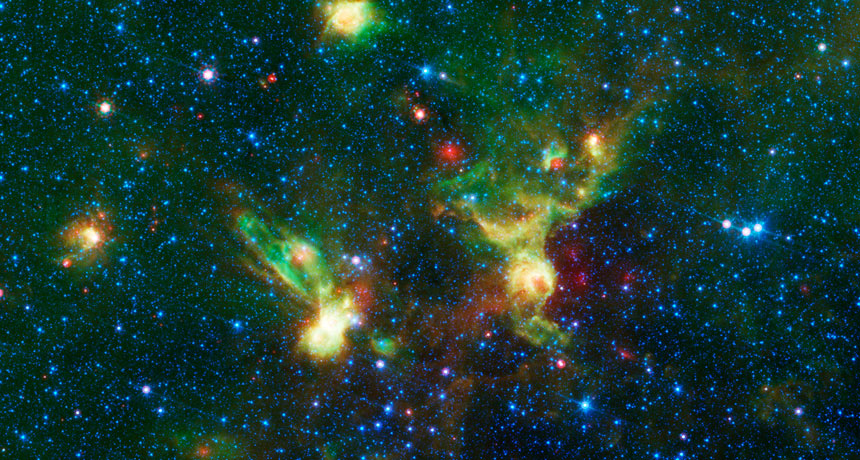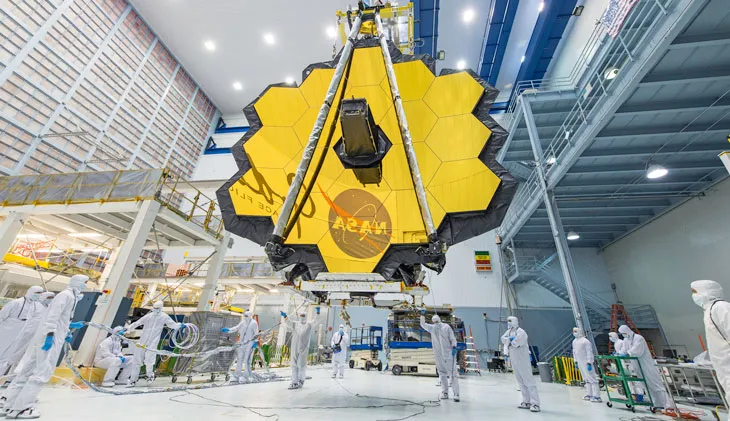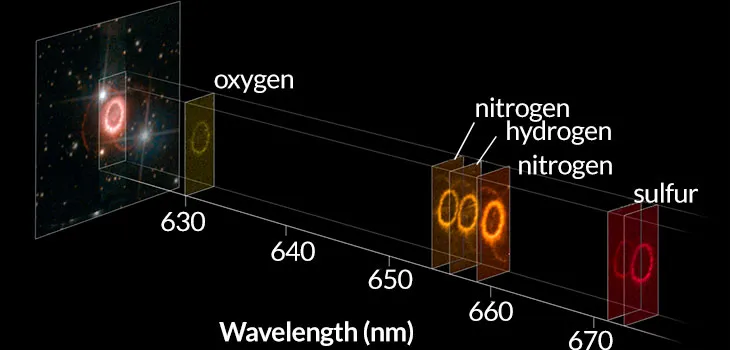James Webb Space Telescope challenges artists to see in infrared
Astronomy artists plan to make raw data beautiful

FIELD OF GREENS Visualizations of images from the upcoming James Webb Space Telescope could look akin to these from the Spitzer Space Telescope. Both telescopes are designed to see in the infrared. In this Spitzer image of the Enterprise nebulae, 3.5 micrometer light is in blue, 8 micrometer light is green and 24 micrometer light is red.
NASA/JPL-Caltech
- More than 2 years ago
With an astronomer’s toolkit and an artist’s eye, Zoltan Levay has transformed raw data from the Hubble Space Telescope into stunning space vistas for almost a quarter century (SN: 4/18/15, p. 4). He’s now preparing for a new challenge: Working with light not visible to human eyes.
Levay’s next charge is the James Webb Space Telescope, set to launch in 2019. Unlike Hubble, which mostly views the universe in visible light, Webb will observe in infrared, with wavelengths too long for human eyes to detect.
“We’re translating this invisible light into the visible range, so we can visualize it,” Levay says.
The switch is worth making because the telescope will see further back in time than Hubble — possibly to the universe’s first stars and galaxies, whose light has been stretched by cosmic expansion.
But it also makes the most common question Levay gets — “What does it really look like?” — tougher to answer.

“The most important thing for us is we don’t want to make things up,” says Joseph DePasquale, a science visualizer who in March 2017 joined Levay at the Space Telescope Science Institute in Baltimore. Both have academic training in astronomy and informal training in art (Levay in photography, DePasquale in painting).
The main challenge will be color, DePasquale says. The artists will employ a “chromatic ordering” strategy used for other observatories, including Hubble. Each infrared wavelength in the range captured by the telescope will be assigned a color. The longest will be red, the shortest blue and the rest in between.
But the pair worry that Webb’s images might look too fake. Hubble captures something close to real colors, but in similarly processed images from the infrared Spitzer Space Telescope, all stars appear blue (because stars emit more light at visible wavelengths and in the near-infrared). Spitzer images also can be dominated by gas in mid-wavelength greens.
“There’s nothing inherently wrong with that,” DePasquale says, but he’s uncertain about the aesthetics. And so, the team hasn’t chosen the palette for James Webb’s images yet.
Slice of space
Hubble observations of supernova remnant SN 1987A split light into a spectrum to show the distribution of different chemical elements. Science visualizers fan out the images at different wavelengths to illustrate the data.

Another challenge will be visualizing spectra, rainbows of split-up light that can reveal chemical composition. Compared with Hubble’s, much more of Webb’s data will come in spectral form, Levay says. But spectra are often presented as simple bands of color. How will the team bring spectra to life?
The pair will also decide whether to leave in visual side effects of how the telescope works. When Hubble’s cameras create cross hairs coming out of bright stars, for instance, Levay and DePasquale let them be. “That’s an artifact, but it’s visually pleasing, so it stays,” DePasquale says. The honeycomb pattern of Webb’s mirrors might likewise imprint itself on the stars in the images, like an artist’s signature.
It’s hard to know if Webb’s images will become as iconic as Hubble’s — or more so. “Hubble grew up pretty much at the same time as the Internet and ultimately was one of the first observatories to enjoy ‘mass-market’ distribution of results,” Levay says. By contrast, the Webb telescope is already on Twitter, and it hasn’t even launched yet. It has the potential to reach a huge audience from the very beginning.
One thing is certain. “We’ll see some amazing images,” Levay says.







